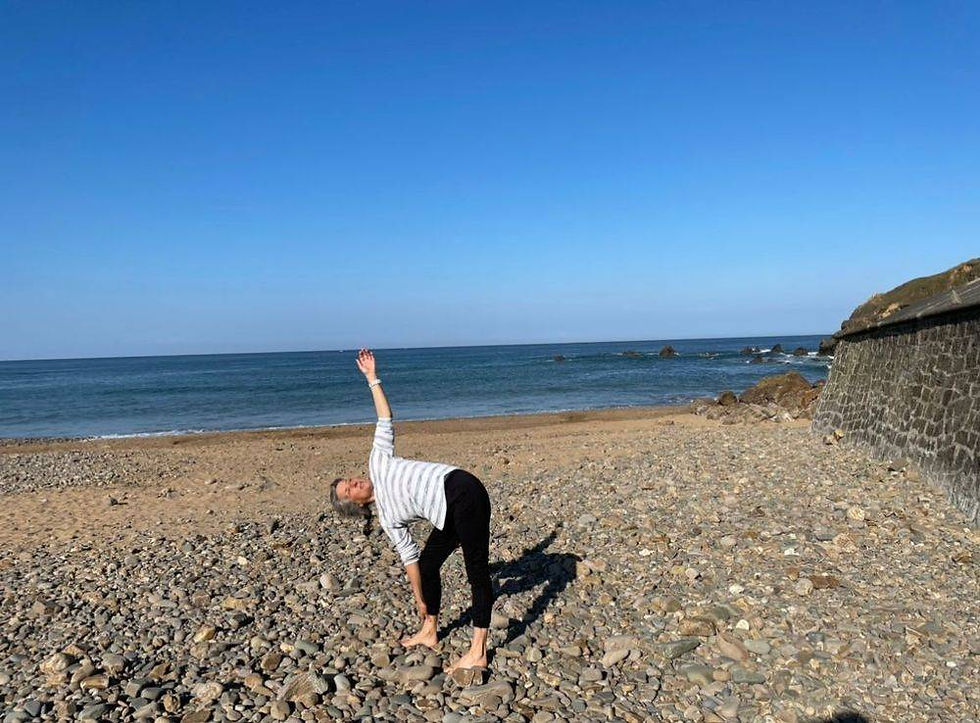Twist & Shout
- Donna Negus

- Aug 28
- 4 min read

Author; Donna Negus ( DCT, FC Tutor and Yoga student)
The possibility of finding expansion and freedom in our practice.
How often do we think (or are told) to be smaller; to lose weight; to drop a clothes size; to not be so loud? If these resonate with you then you are not alone.
What would it be like if you shouted out what you needed? If you widened your body and filled the space around you and decided that all the tension, fears and worries we hold in our body need not be condensed but can be released and let go of. There is a way of working with your body that allows this possibility.
In her book; Awakening The Spine, Vanda Scaravelli says the only way to practice yoga is ‘for the fun of it’
To twist, stretch and move around, is pleasant and enjoyable, a body holiday.
With this in mind when we work with twists ( or any body movement) we do not force ‘shapes’ and we work with care as if we are holding something precious, because we are. Our Yoga practice gives us the possibility of reversing habits, changing entrenched patterns of movement and finding space and freedom.
Why is this integral to our practice?
As we get older our body proves to be a harbour for emotion. Fear, grief, anger ( to name a few!) rest in our shoulders, hips, if not the whole of or body and emotional centres ( Keleman S 1985 Emotional Anatomy) It takes a moment for so called negative emotions to find a place to fester but it can take far longer for emotions such as happiness, contentment and love to replace them (Hanson R 2009 Buddha’s Brain ).
There is a real need for us to release what we hold onto and this is an ongoing challenge. It is like clearing out our loft space. We go through our belongings ready to discard them but how often do we decide to hold on to something we haven’t used in years? What we hold in our body is the same. We are accustomed to holding ourselves in a certain way. We are familiar with this and change is scary. Patterns and habits hold us captive; cause discomfort and even pain. Learning to break them begins with cultivating attention.
Working with a wide legged seated twist
Practicing with a ‘Beginners Mind’ is vital. This allows us to cultivate presence and gives us the possibility on being able to focus/attend on ourselves as we are and not how we think we should be, was yesterday or could be tomorrow.
A Beginner’s Mind allows us to simplify movement:
Find a comfortable seated position. We can take a wide legged position ( but not stretched) in order to find a feeling of width and space. Take time to find your sitting bones and imagine the space between them widening. We can imagine space inside our pelvis and even visualise the sitting bones growing down into the ground like roots. Just as roots travel down through the earth to create stability they also absorb nourishment to allow the upward growth and expansion of the connected body.
The contact of the sitting bones can mirror the connection of the heels to the ground and if we can send the outside edges of the feet away we may get a sense of the outer hips widening.
Our spine will thank us for this attention because when we find a stable base (whether, we are sitting or standing) our spine will ‘wake up’. We know the tailbone, sacrum and lumbar spine have limited (if any) ability to rotate but the twist will begin from the base/root of our spine. As our attention travels upwards from here through the lumbar spine to the thoracic we can feel/visualise our body widening and expanding. Our thoracic spine gives us around 35 degrees rotation and if we can unfold our arms as though we are embracing the Sun we can feel open and free and we can turn.
If our arms feel heavy, while twisting to the left, the right hand can be placed on the inside of the right knee and the left hand by the left hip. We can imagine the right back ribs turning towards the left knee. Simultaneously, feel the upward movement of the spine; from the base through the crown of the head and beyond. In this way, we can feel bigger and wider; taller and stronger. We may feel space in our throat and the wonder of this movement allows our body to internally ‘shout’ with the simple joy of being able to move.
This is not a performance of a ‘shape’ but an awareness of the amazing body we have and the surrender to each moment. This way of practicing can be translated into all twisting asanas and the attention you cultivate to your physical experience will eventually translate to your emotional wellbeing. Twists allow us to grow bigger and wider. Imagine how it would be if you were not afraid; if you let your voice be heard and you were utterly content with everything just as it is? Your attention is everything and your practice is the beginning.
References/bibliography
Calais- Germain B (1985) Anatomy of Movement Eastland Press
Hanson R (2009) Buddha’s Brain New Harbinger Publications
Keleman S (1985) Emotional Anatomy Center Press
Scaravelli V (1991) Awakening The Spine Labyrinth Publishing
About Donna
I have been practicing yoga for over 35 years and teaching with the BWY for 20. My yoga journey is profoundly influenced by the insights of Vanda Scaravelli and I have been taught by her dedicated students.
I am currently teaching my first Diploma Course. For more information on my practice and teaching; donnanegusyoga.co.uk




Comments